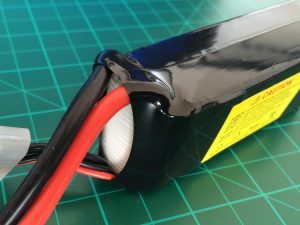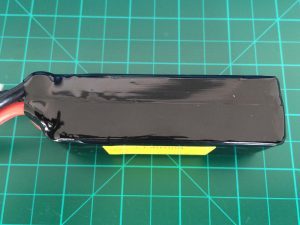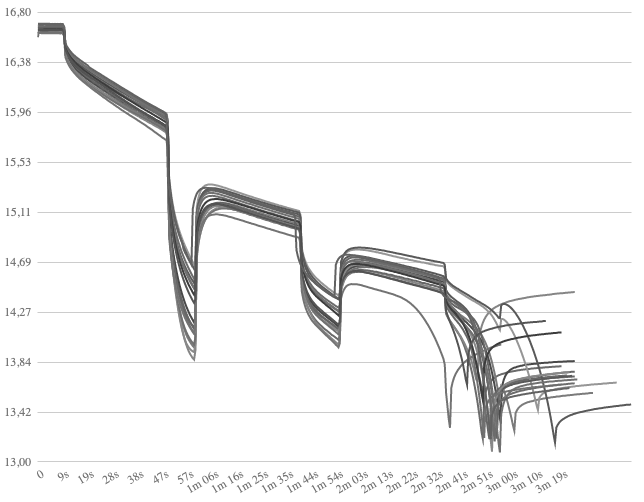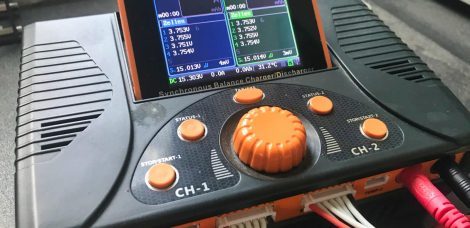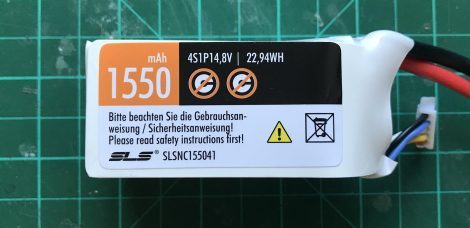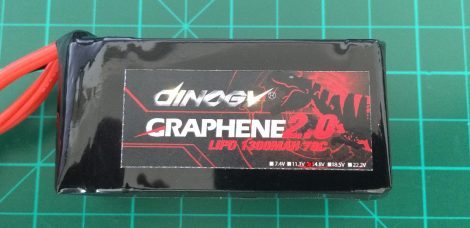MRP (Multirotorparts) has it’s own battery line-up. All 4S, all purely dedicated to mini quad racers in the world. The 1500 mAh version is the second largest pack of the family. This review will have a closer look at the MRP 4S 1500 mAh 65-130 C battery.
Appearance
The MRP lipo packs don’t feature any special design. The pack is protected by some black shrink wrapping. The sides are made of some textured white material, holding the single cells together. The front side has a colored product sticker glued to it, stating name and type of the battery. On the back you find a yellow sticker with the usual warning messages. Over all build quality is solid. No need to complain. Everything looks very well made and feels firm.
Technical Design
The MRP 4S 1500 mAh 65-130 C pack is a standard 4S1P config flight pack for high power use.
Build Quality: Very good. Pack feels very well made on the outside. Connection terminal looks solid. Shrink wrapping job is good.
Plugs: The MRP batteries come with pre-installed XT60 connectors*. Plug and play for most of the pilots. The connectors sit very firm, good quality XT60s.
Cables: MRP uses 12 AWG wires on this packs. Kind of funny, as the larger 1800 mAh battery only has 14 AWG diameter wire. The high flexible silicon layer is rated up to 200°C. Cable length is about 9 centimeters.
Balacing plugs: Standard XT-system*. Balance wires are rather short (3 cm) which is a benefit in terms of getting them out of the way on your quad. The balancer plug is equipped with some transparent housing for easier unplugging. Balancer and main power leads are placed on top and bottom of the pack.
Technical Details
Break-in documentation
The battery followed the standard break-in-process: The pack is charged at a rate of 1C until CV-phase ends with current of 1/10C. The break-in phase consists of four charging cycles at 1C and four corresponding discharges at 1 C / 4C / 10C and 20 C.
Anomalies: No anomalies during break-in.
Internal resistance measurements during break-in phase via iCharger 406B at 40°C pack temperature
| Cycle | Cell 1 | Cell 2 | Cell 3 | Cell 4 | Total |
| After first charge | 2.1 | 2.1 | 1.6 | 2.1 | 7.9 |
| After second charge | 2.0 | 2.0 | 1.6 | 2.1 | 7.1 |
| After third charge | 2.0 | 2.2 | 1.4 | 2.2 | 7.8 |
| After fourth charge | 2.1 | 2.5 | 1.7 | 2.2 | 8.5 |
Charging process
CV-Phase is really short on this cell type. Balacing in normal mode took 1:50 min. Cell drift during charge was unobtrusive. This is for 1C charge (1,5 A).
Load Testing
The main part of this battery test will consists of different load test settings showing the battery performance. Constant load testing is used to judge the advertised C-ratings as well as look at cell drift under high loads. We also check on internal resistance once more. Next up is the dynamic current test, which simulates a „real“ flight with changing (=dynamic) loads. For test methodology please check the dedicated methodology page!
Constant Load Testing
Constant load testing follows a certain load pattern of different constant currents. Base load is 10 C. Current pulses at 50 C, 35 C, 20 C and 30 C are maintained for time intervals between 10 and 20 seconds. For more details please refer to the test methodology page.
Capacity Usage
During this test the pack delivered 1085 mAh. This is 72.3 % of nominal capacity. A solid very value.
Average cell voltages
The following table lists the average voltages per cell, of the total pack, as well as the averaged value per cell as fraction of total voltage during phase of active load.
| Cell 1 | Cell 2 | Cell 3 | Cell 4 | Total | Average per cell | |
| Avg. Voltages | 3.745 | 3.744 | 3.738 | 3.723 | 14.950 | 3.737 |
Just looking at average values the MRP pack performs well. All cells stayed well above 3.71 V on average. An average value above 3.70 V / cell can be considered very good in this class.
Focus Voltages
Exceptionally interesting when testing a battery under a constant load for a longer period of time: the lowest voltage per cell just before load impulse is disabled. On top, you should have look at voltage recovery rate, that is: how fast do cell voltages rise again once load impulse is cut.
| Phase | Cell 1 | Cell 2 | Cell 3 | Cell 4 | Total |
| End of 50 C | 3.483 | 3.482 | 3.51 | 3.515 | 13.952 |
| End of 35 C | 3.506 | 3.498 | 3.509 | 3.515 | 14.027 |
| End of 20 C | 3.421 | 3.463 | 3.421 | 3.301 | 13.606 |
| End of 30 C | – | – | – | – | – |
The average cell voltage stability on the MRP pack can be considered good. Still some cells fell below 3.5 V. Nevertheless, the 50 C phase right at the beginning were tough on the pack. Voltages on two cells went straight below the 3,5 V barrier.
Average voltage recovery per second
Those values are specific to the test setting and not valid for the pack in general! Still they allow an estimated guess about how fast voltages rise again after current spikes.
| Cell 1 | Cell 2 | Cell 3 | Cell 4 | Total | |
| Avg. Recovery [V/s] | 0.0463 | 0.0469 | 0.0433 | 0.0389 | 0.176 |
Excessive voltage sag isn’t a problem for this battery. Recovery rates after current pulses are decent, too.
IR-Measurement
IR measurement is conducted using the four current pulses. Resistance for each cell is calculated in all four discharge phases. Shown values are averaged to cancel out different temperature points due to different discharge states during measurements.
| Cell | 1 | 2 | 3 | 4 | Total |
| Resistance [mΩ] | 3.24 | 3.33 | 3.16 | 3.65 | 13.38 |
Interpretation: The internal resistance of 3.33 mΩ average per cell indicates a „true“ C-rating of around 35 C (52.2 A). A ordinary value. This calculation is on the conservative side and represents a current draw that will make the pack last for a long time. It becomes visible that this pack would have a hard time reaching the advertised 65 C continuous.
Cell drift under load
| Discharge Phase | 50 C | 35 C | 20 C | 30 C |
| Max Cell drift (V) | 0.047 V | 0.05 | 0.08 | – |
The MRP battery has a low drift during main discharge phase.
Key Temperature Facts
Temperature Development
All temperature probes reported values below cut-off point at 58°C. Max. temp during discharge was around 57.4 °C on top of pack. Note that heating of stressed LiPo packs will continue for some more time even when load is cut.
Market Comparison
The following chart shows all reviewed LiPos in the same product segment for direct comparison of performance. Higher values under load are better.
Note: Comparison will be added, once appropriate samples are available.
Constant 25 C Discharge
Pretty much a standard benchmark in the LiPo industry.
Cut-Off /warning value for this battery should be chosen 3.5 V minimum. After this point voltage drops very quick. The battery provided 1062 mAh (70,8 %) during the 25 C discharge.
Market Overview
Comparison of different reviewed 1500 mAh batteries under 25 C load.
Note: Comparison will be added, once appropriate samples are available.
Dynamic Load Testing
The dynamic load testing setting consists of two separate discharge scenarios that have been developed of two different real-life FPV flights. Pattern one represents a high speed low proximity flight around the open field with some hovering to the end. Average load is around 22 A. Second pattern is a free-style flight around trees in the park with some current spikes near 70 A. Average load on this flight is around 13 A due to longer floating periods.
Capacity Usage
During the test of pattern 1 the pack delivered 1120 mAh. This is 74.6 % of nominal capacity. A good value. In patter 2 testing 1123 mAh (74.9 %) could be used until first cell reached cut-off voltage.
Market Comparison
The following charts give an overview of all tested packs in the 1500 mAh class so far.
Note: Comparison will be added, once appropriate samples are available.
Conclusion
The MRP 4S 1500 mAh 65-130 C battery is a usual sized pack with a decenent capacity to weight ratio of 8.93 mAh/g. Build quality is very good on the 1500 mAh version – nothing to complain. IR wise we get a „true C-rating“ of around 35 C. That’s just a little too low for an advertised 65 C battery. I think a 45 to 50 C badge would be more appropriate on this pack type. You have to keep in mind, though, that 35 C still will give you a continuous current draw of around 52 A. As current spikes are handled pretty well by the MRP 1500 mAh battery, using it on your mini quad in the 200 to 250 segment is still going to give you good to very good flight performance. Temperatur development is not an issue, but you should be prepared to find a pretty hot pack after you draw continuous high currents. Don’t worry about the fact that the battery will become a little bigger under high loads. This is just the type of cell chemistry working. After a short cool down period the pack is back to normal again. Other manufacturers try to prevent this by the integration of two thin metal plates on each side to hold the cells together even more firmly. Average voltage stability (below 50 C) and recovery rates are good, nothing to complain. The pricing of ~ 32.50 € is attractive. If you just need a little bit more punch and can afford the few extra mm in length you also could get the 1800 mAh version. It’s only slightly more expensive and will give you better high current performance.
Other packs of this line up reviewed:





